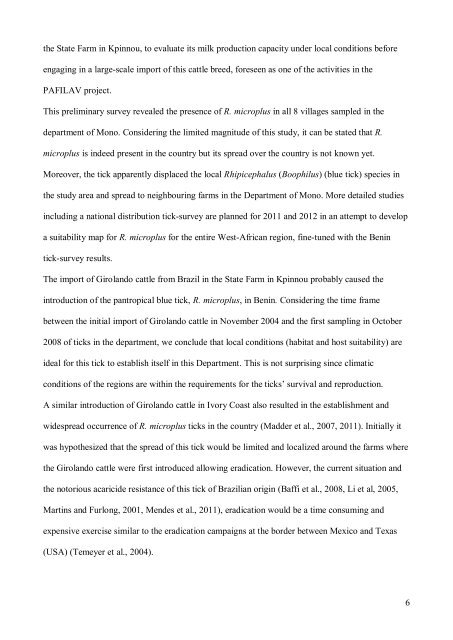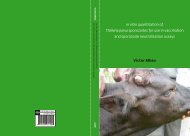Author template for journal articles - Itg
Author template for journal articles - Itg
Author template for journal articles - Itg
You also want an ePaper? Increase the reach of your titles
YUMPU automatically turns print PDFs into web optimized ePapers that Google loves.
the State Farm in Kpinnou, to evaluate its milk production capacity under local conditions be<strong>for</strong>eengaging in a large-scale import of this cattle breed, <strong>for</strong>eseen as one of the activities in thePAFILAV project.This preliminary survey revealed the presence of R. microplus in all 8 villages sampled in thedepartment of Mono. Considering the limited magnitude of this study, it can be stated that R.microplus is indeed present in the country but its spread over the country is not known yet.Moreover, the tick apparently displaced the local Rhipicephalus (Boophilus) (blue tick) species inthe study area and spread to neighbouring farms in the Department of Mono. More detailed studiesincluding a national distribution tick-survey are planned <strong>for</strong> 2011 and 2012 in an attempt to developa suitability map <strong>for</strong> R. microplus <strong>for</strong> the entire West-African region, fine-tuned with the Benintick-survey results.The import of Girolando cattle from Brazil in the State Farm in Kpinnou probably caused theintroduction of the pantropical blue tick, R. microplus, in Benin. Considering the time framebetween the initial import of Girolando cattle in November 2004 and the first sampling in October2008 of ticks in the department, we conclude that local conditions (habitat and host suitability) areideal <strong>for</strong> this tick to establish itself in this Department. This is not surprising since climaticconditions of the regions are within the requirements <strong>for</strong> the ticks’ survival and reproduction.A similar introduction of Girolando cattle in Ivory Coast also resulted in the establishment andwidespread occurrence of R. microplus ticks in the country (Madder et al., 2007, 2011). Initially itwas hypothesized that the spread of this tick would be limited and localized around the farms wherethe Girolando cattle were first introduced allowing eradication. However, the current situation andthe notorious acaricide resistance of this tick of Brazilian origin (Baffi et al., 2008, Li et al, 2005,Martins and Furlong, 2001, Mendes et al., 2011), eradication would be a time consuming andexpensive exercise similar to the eradication campaigns at the border between Mexico and Texas(USA) (Temeyer et al., 2004).6











